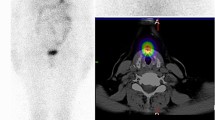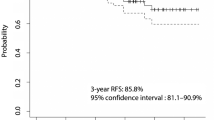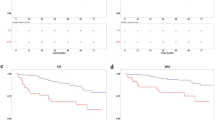Abstract
Background
Female thyroid cancer survivors are more likely to have a higher risk of breast cancer compared to the general population, and the underlying causes are yet to be understood. The potential role of I-131 treatment on this association remains controversial.
Methods
We pooled individual data of women who were treated for differentiated thyroid cancer from 1934 to 2005 in France, Italy and Sweden. Standardized incidence ratios (SIRs) for breast cancer were estimated by comparison with age, sex and calendar-year expected values of the general population in each country. We estimated breast cancer risk in relation to I-131 treatment using time-dependent Poisson models.
Results
Of 8475 women (mean age at diagnosis: 45 years, range 2–90 years), 335 were diagnosed with breast cancer [SIR = 1.52, 95% confidence interval (CI): 1.36–1.69] during a median follow-up time of 12.7 years since diagnosis. Overall, breast cancer risk did not differ between women treated or not with I-131 (relative risk=1.07, 95% CI 0.84–1.35). However, breast cancer risk increased with increasing cumulative I-131 activity, without significant departure from linearity (excess relative risk per 100 mCi=17%, 95% CI: 2% to 38%). The higher risk associated with a cumulative I-131 activity of ≥100 mCi and ≥400 mCi was translated into 4 (95% CI −4 to 13) and 42 (95% CI −8 to 93) excess breast cancer cases per 10,000 person-years, respectively.
Conclusions
An elevated risk was observed for the highest cumulative administered activity (>=400 mCi), and a significant dose-dependent association was observed among thyroid cancer survivors who were treated with I-131. However, overall, I-131 treatment might only explain partly the increase in breast cancer risk among female thyroid cancer survivors.
This is a preview of subscription content, access via your institution
Access options
Subscribe to this journal
Receive 24 print issues and online access
$259.00 per year
only $10.79 per issue
Buy this article
- Purchase on Springer Link
- Instant access to full article PDF
Prices may be subject to local taxes which are calculated during checkout


Similar content being viewed by others
Data availability
The data underlying this paper will be shared upon reasonable request to the corresponding author.
Code availability
The code used to generate results that are reported in the paper will be shared on reasonable request to the corresponding author.
References
Ferlay J, Ervik M, Lam F, Colombet M, Mery L, Piñeros M, et al. Global cancer observatory: cancer today. Lyon, France: International Agency for Research on Cancer, https://gco.iarc.fr/today. Accessed 5 January 2020.
Kitahara CM, Sosa JA. The changing incidence of thyroid cancer. Nat Rev Endocrinol. 2016;12:646–53.
Li M, Dal Maso L, Vaccarella S. Global trends in thyroid cancer incidence and the impact of overdiagnosis. Lancet Diabetes Endocrinol. 2020;8:468–70.
Gilliland FD, Hunt WC, Morris DM, Key CR. Prognostic factors for thyroid carcinoma. A population-based study of 15,698 cases from the Surveillance, Epidemiology and End Results (SEER) program 1973-1991. Cancer. 1997;79:564–73.
Reiners C, Schneider R, Platonova T, Fridman M, Malzahn U, Mäder U, et al. Breast cancer after treatment of differentiated thyroid cancer with radioiodine in young females: what we know and how to investigate open questions. review of the literature and results of a multi-registry survey. Front Endocrinol. 2020;11:381.
Subramanian S, Goldstein DP, Parlea L, Thabane L, Ezzat S, Ibrahim-Zada I, et al. Second primary malignancy risk in thyroid cancer survivors: a systematic review and meta-analysis. Thyroid. 2007;17:1277–88.
Nielsen SM, White MG, Hong S, Aschebrook-Kilfoy B, Kaplan EL, Angelos P, et al. The breast-thyroid cancer link: a systematic review and meta-analysis. Cancer Epidemiol, Biomark Prev. 2016;25:231–8.
Council NR. Health risks from exposure to low levels of ionizing radiation: BEIR VII Phase 2. Washington, DC: The National Academies Press; 2006.
Clement SC, Peeters RP, Ronckers CM, Links TP, van den Heuvel-Eibrink MM, Nieveen van Dijkum EJ, et al. Intermediate and long-term adverse effects of radioiodine therapy for differentiated thyroid carcinoma-a systematic review. Cancer Treat Rev. 2015;41:925–34.
Pukkala E, Kesminiene A, Poliakov S, Ryzhov A, Drozdovitch V, Kovgan L, et al. Breast cancer in Belarus and Ukraine after the Chernobyl accident. Int J Cancer. 2006;119:651–8.
Rivkind N, Stepanenko V, Belukha I, Guenthoer J, Kopecky KJ, Kulikov S, et al. Female breast cancer risk in Bryansk Oblast, Russia, following prolonged low dose rate exposure to radiation from the Chernobyl power station accident. Int J Epidemiol. 2020;49:448–56.
Lin CY, Lin CL, Huang WS, Kao CH. Risk of breast cancer in patients with thyroid cancer receiving or not receiving 131i treatment: a nationwide population-based cohort study. J Nucl Med. 2016;57:685–90.
Pasqual E, Schonfeld S, Morton LM, Villoing D, Lee C, Berrington de Gonzalez A, et al. Association between radioactive iodine treatment for pediatric and young adulthood differentiated thyroid cancer and risk of second primary malignancies. J Clin Oncol. 2022;40:1439–49.
Berthe E, Henry-Amar M, Michels J-J, Rame J-P, Berthet P, Babin E, et al. Risk of second primary cancer following differentiated thyroid cancer. Eur J Nucl Med Mol imaging. 2004;31:685–91.
Ahn HY, Min HS, Yeo Y, Ma SH, Hwang Y, An JH, et al. Radioactive iodine therapy did not significantly increase the incidence and recurrence of subsequent breast cancer. J Clin Endocrinol Metab. 2015;100:3486–93.
Teng CJ, Hu YW, Chen SC, Yeh CM, Chiang HL, Chen TJ, et al. Use of radioactive iodine for thyroid cancer and risk of second primary malignancy: a nationwide population-based study. J Natl Cancer Inst. 2016;108:djv314.
Brown AP, Chen J, Hitchcock YJ, Szabo A, Shrieve DC, Tward JD. The risk of second primary malignancies up to three decades after the treatment of differentiated thyroid cancer. J Clin Endocrinol Metab. 2008;93:504–15.
Kim C, Bi X, Pan D, Chen Y, Carling T, Ma S, et al. The risk of second cancers after diagnosis of primary thyroid cancer is elevated in thyroid microcarcinomas. Thyroid. 2013;23:575–82.
Verkooijen RB, Smit JW, Romijn JA, Stokkel MP. The incidence of second primary tumors in thyroid cancer patients is increased, but not related to treatment of thyroid cancer. Eur J Endocrinol. 2006;155:801–6.
Iyer NG, Morris LG, Tuttle RM, Shaha AR, Ganly I. Rising incidence of second cancers in patients with low-risk (T1N0) thyroid cancer who receive radioactive iodine therapy. Cancer. 2011;117:4439–46.
Yu CY, Saeed O, Goldberg AS, Farooq S, Fazelzad R, Goldstein DP, et al. A systematic review and meta-analysis of subsequent malignant neoplasm risk after radioactive iodine treatment of thyroid cancer. Thyroid. 2018;28:1662–73.
Rubino C, de Vathaire F, Dottorini ME, Hall P, Schvartz C, Couette JE, et al. Second primary malignancies in thyroid cancer patients. Br J Cancer. 2003;89:1638–44.
Hall P, Holm LE, Lundell G, Bjelkengren G, Larsson LG, Lindberg S, et al. Cancer risks in thyroid cancer patients. Br J Cancer. 1991;64:159–63.
Dottorini ME, Lomuscio G, Mazzucchelli L, Vignati A, Colombo L. Assessment of female fertility and carcinogenesis after iodine-131 therapy for differentiated thyroid carcinoma. J Nucl Med. 1995;36:21–7.
de Vathaire F, Schlumberger M, Delisle MJ, Francese C, Challeton C, de la Genardiére E, et al. Leukaemias and cancers following iodine-131 administration for thyroid cancer. Br J Cancer. 1997;75:734–9.
Binder-Foucard F, Bossard N, Delafosse P, Belot A, Woronoff AS, Remontet L. Cancer incidence and mortality in France over the 1980–2012 period: solid tumors. Rev d'Épidémiologie et de Sté Publique. 2014;62:95–108.
Bray F, Ferlay J, Laversanne M, Brewster DH, Gombe Mbalawa C, Kohler B, et al. Cancer incidence in five continents: inclusion criteria, highlights from volume X and the global status of cancer registration. Int J Cancer. 2015;137:2060–71.
National Board of Health and Welfare. Cancer incidence in Sweden, https://sdb.socialstyrelsen.se/if_can/val_eng.aspx Accessed 21 October.
Preston DL, Mattsson A, Holmberg E, Shore R, Hildreth NG, Boice JD Jr. Radiation effects on breast cancer risk: a pooled analysis of eight cohorts. Radiat Res. 2002;158:220–35.
Ronckers CM, Erdmann CA, Land CE. Radiation and breast cancer: a review of current evidence. Breast Cancer Res: BCR. 2005;7:21–32.
Land CE, Tokunaga M, Koyama K, Soda M, Preston DL, Nishimori I, et al. Incidence of female breast cancer among atomic bomb survivors, Hiroshima and Nagasaki, 1950-1990. Radiat Res. 2003;160:707–17.
Ulm K. A statistical method for assessing a threshold in epidemiological studies. Stat Med. 1991;10:341–9.
Haugen BR, Alexander EK, Bible KC, Doherty GM, Mandel SJ, Nikiforov YE, et al. 2015 American Thyroid Association Management Guidelines for Adult Patients with Thyroid Nodules and Differentiated Thyroid Cancer: The American Thyroid Association Guidelines Task Force on Thyroid Nodules and Differentiated Thyroid Cancer. Thyroid. 2016;26:1–133.
Preston D, Lubin J, Pierce D, McConney M. Epicure users guide. Seattle, WA: Hirosoft International Corporation, 1993;186..
Kitahara CM, Berrington de Gonzalez A, Bouville A, Brill AB, Doody MM, Melo DR, et al. Association of radioactive iodine treatment with cancer mortality in patients with hyperthyroidism. JAMA Intern Med. 2019;179:1034–42.
Berrington de Gonzalez A, Gilbert E, Curtis R, Inskip P, Kleinerman R, Morton L, et al. Second solid cancers after radiation therapy: a systematic review of the epidemiologic studies of the radiation dose-response relationship. Int J Radiat Oncol Biol Phys. 2013;86:224–33.
Preston DL, Kitahara CM, Freedman DM, Sigurdson AJ, Simon SL, Little MP, et al. Breast cancer risk and protracted low-to-moderate dose occupational radiation exposure in the US Radiologic Technologists Cohort, 1983-2008. Br J Cancer. 2016;115:1105–12.
Preston DL, Ron E, Tokuoka S, Funamoto S, Nishi N, Soda M, et al. Solid cancer incidence in atomic bomb survivors: 1958-1998. Radiat Res. 2007;168:1–64.
Brenner AV, Preston DL, Sakata R, Sugiyama H, de Gonzalez AB, French B, et al. Incidence of breast cancer in the life span study of atomic bomb survivors: 1958-2009. Radiat Res. 2018;190:433–44.
Davis FG, Yu KL, Preston D, Epifanova S, Degteva M, Akleyev AV. Solid cancer incidence in the Techa river incidence cohort: 1956-2007. Radiat Res. 2015;184:56–65.
Metso S, Auvinen A, Huhtala H, Salmi J, Oksala H, Jaatinen P. Increased cancer incidence after radioiodine treatment for hyperthyroidism. Cancer. 2007;109:1972–9.
Luster M, Clarke SE, Dietlein M, Lassmann M, Lind P, Oyen WJ, et al. Guidelines for radioiodine therapy of differentiated thyroid cancer. Eur J Nucl Med Mol imaging. 2008;35:1941–59.
Acknowledgements
We would like to thank Dr. Carine Corone for her contribution on the setting up of the study at the Rene Huguenin Center.
Funding
Thi-Van-Trinh TRAN received a doctoral grant from the Paris Sud-Paris Saclay University. Michel Henry-Amar is supported by the French National League Against Cancer (LNC). This study was supported by grants from the European Commission (Concerted action no. FI4P-CT98-0078, DG 12-WSMN), and European Community’s Seventh Framework Program (EURATOM) contract Fission-269553 (EpiRadBio), and by the Epidemiology Commission of Electricity of France (EDF). Role of funders: The funders do not have any role in the conception and the analysis of the study nor in the writing or the article.
Author information
Authors and Affiliations
Contributions
Study conception and design: FDV, CR, TTVT, MS, MD, PH, SL and ID. Statistical analysis: TTVT, CR, FDV and NJ. writing of the original draft: TTVT. Interpretation of the results: FDV, TTVT, CR, NJ and MS. All authors revised the paper and approved the final version.
Corresponding authors
Ethics declarations
Competing interests
The authors declare no competing interests.
Ethics approval and consent to participate
The French cohort’s protocol has been approved by the French National Agency regulating Data Protection (CNIL), and consent was obtained from the study participants. The Swedish cohort obtained approval from the Swedish data inspection board. Because the sole aim of the Italian cohort is to evaluate the safety of radio-iodine treatment administered by medical doctors of this hospital, without any other specific contact with patients, no special authorization has been needed for this population. The pooled cohort study contains only pseudonymized individual data.
Consent to publish
Not applicable.
Additional information
Publisher’s note Springer Nature remains neutral with regard to jurisdictional claims in published maps and institutional affiliations.
Rights and permissions
Springer Nature or its licensor holds exclusive rights to this article under a publishing agreement with the author(s) or other rightsholder(s); author self-archiving of the accepted manuscript version of this article is solely governed by the terms of such publishing agreement and applicable law.
About this article
Cite this article
Tran, TVT., Rubino, C., Allodji, R. et al. Breast cancer risk among thyroid cancer survivors and the role of I-131 treatment. Br J Cancer 127, 2118–2124 (2022). https://doi.org/10.1038/s41416-022-01982-5
Received:
Revised:
Accepted:
Published:
Issue Date:
DOI: https://doi.org/10.1038/s41416-022-01982-5



